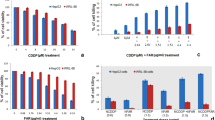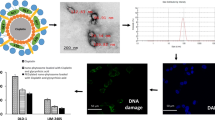Abstract
Hepatocellular carcinoma (HCC) is one of the most common malignancies worldwide with poor chemotherapeutic efficiency due to multidrug resistance (MDR); it is very important to develop a targeted nanocarrier for the treatment of HCC. In this study, a programmed death ligand 1 (PD-L1)–conjugated nanoliposome was constructed for co-delivery of paclitaxel (PTX) and P-glycoprotein (P-gp) inhibitor zosuquidar (ZSQ) to overcome MDR in human HCC cells and tumors in vivo. Transmission electron microscopy (TEM) and nanoparticle tracking analysis (NTA) were used to examine the nanoparticles morphology and size; PD-1-conjugated PTX and ZSQ-loaded nanoliposomes (PD-PZLP) revealed a spherical shape with a size of 139.5 ± 10.7 nm. Then, the physicochemical properties, as well as the drug loading capacity, release profile, cellular uptake, and cytotoxicity of the dual drug-encapsulated nanoliposomes were characterized. PD-PZLP displayed a high drug loading capacity of 20 ~ 30% for both PTX and ZSQ; the drug release of PTX and ZSQ in pH 5.0 was significantly faster than in pH 7.4. Cellular uptake study demonstrated PD-PZLP had higher internalization efficiency than non-targeted PZLP. Terminal deoxynucleotidyl transferase dUTP nick end labeling (TUNEL) staining and reactive oxygen species (ROS) analysis demonstrated that PD-PZLP triggered an excessive ROS reaction and cell apoptosis compared with that of free PTX or ZSQ, which was also consistent with the cell antiproliferative effects in MTT assay. Furthermore, PD-PZLP could enhance synergistic antitumor effects on 7721/ADM xenograft tumor model, which also significantly alleviated hepatotoxicity as evident from the decreased aspartate transaminase (AST) and alanine transaminase (ALT) levels. Overall, PD-PZLP exhibited high loading capacity, significant synergistic effects, promising antitumor efficacy, and the lowest toxicity, which provide a promising strategy to overcome MDR in HCC.
Graphical abstract








Similar content being viewed by others
Availability of data and materials
The datasets used or analyzed during the current study are available from the corresponding author.
Abbreviations
- HCC:
-
Hepatocellular carcinoma
- MDR:
-
Multidrug resistance
- P-gp:
-
P-glycoprotein
- PTX:
-
Paclitaxel
- ZSQ:
-
Zosuquidar
- PD-L1:
-
Programmed death ligand1
- PD-PZLP:
-
PD-L1-conjugated PTX and ZSQ-loaded nanoliposomes
- ROS:
-
Reactive oxygen species
- EPR:
-
Enhanced permeation and retention
- NTA:
-
Nanoparticle tracking analysis
- TEM:
-
Transmission electron microscope
- HPLC:
-
High-performance liquid chromatography system
- PBS:
-
Phosphate-buffered saline
- DAPI:
-
4,6-Diamidino-2-phenylindole
- PFA:
-
Paraformaldehyde
- CLSM:
-
confocal laser scanning microscope
- SDS-PAGE:
-
Sodium dodecyl sulfate–polyacrylamide gels
- PVDF:
-
Polyvinylidene fluoride
- CI:
-
Combination index
- TUNEL:
-
Terminal deoxynucleotidyl transferase dUTP nick end labeling
- IHC:
-
Immunohistochemical
- AST:
-
Aspartate transaminase
- ALT:
-
Alanine transaminase
- TBST:
-
Tris‑buffered saline with Tween 20
- ECL:
-
enhanced chemiluminescence
- mAb:
-
monoclonal antibodies
- FITC:
-
Fluorescein Isothiocyanate
- DCFH-DA:
-
dichlorofluorescin diacetate
- DAB:
-
diaminebenzidine
References
Shimizu Y, et al. Segmental analysis of respiratory liver motion in patients with and without a history of abdominal surgery. Jpn J Radiol. 2018;36(8):1–8.
Forner A, Llovet JM, Bruix J. Hepatocellular carcinoma. Lancet. 2012;379(9822):1245–55.
Villanueva A. Hepatocellular carcinoma. N Engl J Med. 2019;380(15):1450–62.
Waghray A, Murali AR, Menon KN. Hepatocellular carcinoma: from diagnosis to treatment. World J Hepatol. 2015;7(8):1020.
Singh MS, et al. MDR in cancer: addressing the underlying cellular alterations with the use of nanocarriers. Pharmacol Res. 2017;126:2–30.
Horwitz MS, Torrespoveda K. Mechanisms of taxol-induced cell death are concentration dependent. Can Res. 1998;58(16):3620–6.
Yang Y-H, Mao J-W, Tan X-L. Research progress on the source, production, and anti-cancer mechanisms of paclitaxel. Chin J Nat Med. 2020;18(12):890–7.
Jimenez-Lopez J, et al. Paclitaxel antitumor effect improvement in lung cancer and prevention of the painful neuropathy using large pegylated cationic liposomes. Biomed Pharmacother. 2021;133:111059.
Liu Y, et al. Paclitaxel suppresses hepatocellular carcinoma tumorigenesis through regulating Circ-BIRC6/miR-877-5p/YWHAZ axis. Onco Targets Ther. 2020;13:9377–88.
Zhu D, et al. Folate-targeted polymersomes loaded with both paclitaxel and doxorubicin for the combination chemotherapy of hepatocellular carcinoma. Acta Biomater. 2017;58:399–412.
Ma G, et al. Multi-functionalized dendrimers for targeted co-delivery of sorafenib and paclitaxel in liver cancers. J Drug Delivery Sci Technol. 2021;63:102493.
Du Z, et al. TPGS-galactose-modified polydopamine co-delivery nanoparticles of nitric oxide donor and doxorubicin for targeted chemo-photothermal therapy against drug-resistant hepatocellular carcinoma. ACS Appl Mater Interfaces. 2021;13(30):35518–32.
Cai L, et al. Telodendrimer nanocarrier for co-delivery of paclitaxel and cisplatin: A synergistic combination nanotherapy for ovarian cancer treatment. Biomaterials. 2015;37:456–68.
Liu M, et al. Intracellular target delivery of 10-hydroxycamptothecin with solid lipid nanoparticles against multidrug resistance. J Drug Target. 2015;23(9):800–5.
Ghaleb H, et al. Design, synthesis and evaluation of a novel series of inhibitors reversing P-glycoprotein-mediated multidrug resistance. Chem Biol Drug Des. 2018;92(3):1708–16.
Lei M, et al. Dual-functionalized liposome by co-delivery of paclitaxel with sorafenib for synergistic antitumor efficacy and reversion of multidrug resistance. Drug Deliv. 2019;26(1):262–72.
Sprachman MM, et al. In vivo imaging of multidrug resistance using a third generation MDR1 inhibitor. Bioconjug Chem. 2014;25(6):1137.
Baig B, et al. Current status of nanomaterial-based treatment for hepatocellular carcinoma. Biomed Pharmacother. 2019;116:108852.
Lu J, Wang J, Ling D. Surface engineering of nanoparticles for targeted delivery to hepatocellular carcinoma. Small. 2018;14(5):1702037.
Beltrán-Gracia E, et al. Nanomedicine review: clinical developments in liposomal applications. Cancer Nanotechnol. 2019;10(1):1–40.
Mitchell MJ, et al. Engineering precision nanoparticles for drug delivery. Nat Rev Drug Discov. 2021;20(2):101–24.
Kim JS. Liposomal drug delivery system. J Pharm Investig. 2016;46(4):387–92.
Park J, et al. Alliance with EPR effect: combined strategies to improve the EPR effect in the tumor microenvironment. Theranostics. 2019;9(26):8073–90.
Aronson MR, Medina SH, Mitchell MJ. Peptide functionalized liposomes for receptor targeted cancer therapy. APL Bioeng. 2021;5(1):011501.
de Mello RA, et al. New target therapies in advanced non-small cell lung cancer: a review of the literature and future perspectives. J Clin Med. 2020;9(11):3543.
Setordzi P, et al. The recent advances of PD-1 and PD-L1 checkpoint signaling inhibition for breast cancer immunotherapy. Eur J Pharmacol. 2021;895:173867.
Wu L, et al. PD-1/PD-L1 enhanced cisplatin resistance in gastric cancer through PI3K/AKT mediated P-gp expression. Int Immunopharmacol. 2021;94:107443.
Wu Q, et al. Small molecule inhibitors targeting the PD-1/PD-L1 signaling pathway. Acta Pharmacol Sin. 2021;42(1):1–9.
Cui H, Dai G, Guan J. Programmed cell death protein-1 (PD-1)-targeted immunotherapy for advanced hepatocellular carcinoma in real world. Onco Targets Ther. 2020;13:143–9.
Mocan T, et al. Programmed cell death protein-1 (PD-1)/programmed death-ligand-1 (PD-L1) axis in hepatocellular carcinoma: prognostic and therapeutic perspectives. Clin Transl Oncol. 2019;21(6):702–12.
Liao H, et al. Expression of programmed cell death-ligands in hepatocellular carcinoma: correlation with immune microenvironment and survival outcomes. Front Oncol. 2019;9:883.
Jung HI, et al. Overexpression of PD-L1 and PD-L2 is associated with poor prognosis in patients with hepatocellular carcinoma. Cancer Res Treat. 2017;49(1):246–54.
Yu J, et al. PD-L1 monoclonal antibody-decorated nanoliposomes loaded with paclitaxel and P-gp transport inhibitor for the synergistic chemotherapy against multidrug resistant gastric cancers. Nanoscale Res Lett. 2020;15(1):59.
Yusuf RZ, Duan Z, Lamendola DE, Penson RT, Seiden MV. Paclitaxel resistance: molecular mechanisms and pharmacologic manipulation. Curr Cancer Drug Targets. 2003;3(1):1–9.
Patel NR, et al. Reversal of multidrug resistance by co-delivery of tariquidar (XR9576) and paclitaxel using long-circulating liposomes. Int J Pharm. 2011;416(1):296–9.
Chen D, et al. Adjudin-loaded redox-sensitive paclitaxel-prodrug micelles for overcoming multidrug resistance with efficient targeted Colon cancer therapy. Drug Deliv. 2020;27(1):1094–105.
Farooq MA, et al. Enhanced cellular uptake and cytotoxicity of vorinostat through encapsulation in TPGS-modified liposomes. Colloids Surf B Biointerfaces. 2021;199:111523.
Hu Y, et al. Synergistic inhibition of drug-resistant colon cancer growth with PI3K/mTOR dual inhibitor BEZ235 and nano-emulsioned paclitaxel via reducing multidrug resistance and promoting apoptosis. Int J Nanomedicine. 2021;16:2173–86.
Davis ME, Chen ZG, Shin DM. Nanoparticle therapeutics: an emerging treatment modality for cancer. Nat Rev Drug Discov. 2008;7(9):771–82.
Funding
All sources of funding were supported by the Medical and Health Project of Suzhou High-tech district (2018Z006).
Author information
Authors and Affiliations
Contributions
Mingjia Gu and Fang Yin: conceptualization, methodology, investigation, writing — original draft. Yuening Qin and Yali Tian: methodology, data curation; formal analysis, validation; Xinjie Xiu and Hanjing Shen: software; supervision, visualization. Jiebin Zhu: conceptualization, writing — review and editing, supervision, project administration. All persons mentioned above have made substantial contributions to the work in the manuscript.
Corresponding author
Ethics declarations
Ethics approval and consent to participate
Not applicable.
Consent for publication
All authors whose names appear on the submission approved the version to be published.
Competing interests
The authors declare no competing interests.
Additional information
Publisher's Note
Springer Nature remains neutral with regard to jurisdictional claims in published maps and institutional affiliations.
Rights and permissions
About this article
Cite this article
Gu, M., Yin, F., Qin, Y. et al. Synergistic antitumor efficacy of PD-1-conjugated PTX- and ZSQ-loaded nanoliposomes against multidrug-resistant liver cancers. Drug Deliv. and Transl. Res. 12, 2550–2560 (2022). https://doi.org/10.1007/s13346-021-01106-1
Accepted:
Published:
Issue Date:
DOI: https://doi.org/10.1007/s13346-021-01106-1




